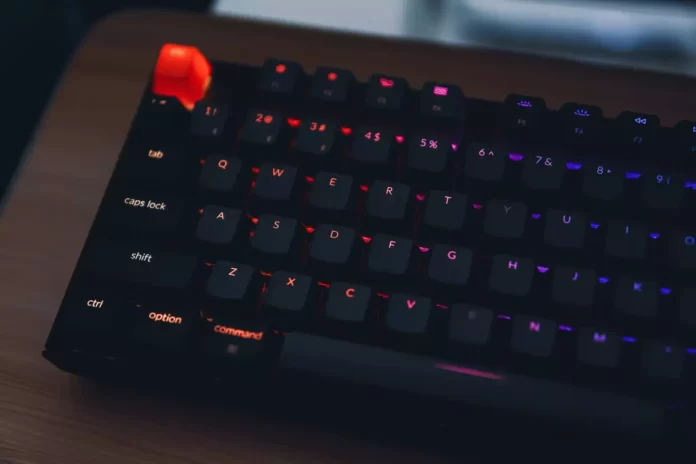Typing on the keyboard users don’t think about how it works until they encounter a problem that requires an understanding of its inner workings. Often users and gamers are faced with problems related to the simultaneous pressing of multiple keys.
What do you need to know about N-Key rollover (NKRO)
Once upon a time gaming keyboards, as you know, didn’t exist in nature at all. However, even with the current abundance of models with mechanical buttons, RGB lighting, and other super technological features, it’s not so easy to understand what is the difference between a real gaming keyboard and all the others.
Often in the specifications describing a particular gaming keyboard, there’s the term Anti-Ghosting, otherwise known as “phantom pressing”. This term is usually used when describing the technology that protects the keyboard from such manifestations. A novice gamer can guess that this feature is useful and perhaps every gaming keyboard should have it.
However, not understanding the essence of the processes, the buyer doesn’t fully realize the importance of the Anti-Ghosting system and chooses a device, even without such protection, but cheaper.
There’s also a term Key Rollover (KRO). This is the registration of parallel presses. Everyone has faced this problem at least once. If you press several keys at once, not all of them will respond, maybe not even in the order you pressed them. In general, mechanical keyboards support 6 simultaneous keystrokes (but not all of them).
NKRO is an unlimited number of presses (only high-quality mechanical keyboards have this feature). Well, here’s more about NKRO (N-Key rollover).
What do #KRO and NKRO mean
#KRO – number of simultaneously pressed keys, the signal from which the keyboard is able to receive and transmit to the PC. Devices are different, therefore the number of simultaneous keystrokes may differ for certain models.
Therefore, at the beginning of the abbreviation, instead of the grid, they put a number that shows how many simultaneous keystrokes the keyboard can receive. For example, 3KRO is no more than three keys simultaneously. This feature is characteristic of membrane keyboards that are used for work.
Gaming membrane consoles are marked from 6KRO. In most cases, this is enough for comfortable gameplay. Marking NKRO means that the keyboard is able to produce a signal from an unlimited number of simultaneously pressed buttons.
In practice, NKRO means that the keyboard will always respond correctly to all commands, including in today’s dynamic shooters, where you have a lot of actions (run, jump, crouch, fall, reload, change weapons, etc.) to perform simultaneously and they’re assigned to different buttons.
What are phantom or ghost presses
Ghosting (a.k.a. “ghost pressing”) is signaling from a key that you haven’t touched. The problem lies in the design feature of membrane keyboards. If for the office work it doesn’t have any negative consequences. However, for the gameplay, the “phantom press” is a very unpleasant thing.
If the keyboard has a limit on the number of keys pressed simultaneously, it’s likely that the signal from the phantom press will block the gamer’s command, precious seconds will be lost and you will lose a conditional round.
Without going into detail, it should be noted that there are two ways to protect yourself from this kind of trouble:
- You can buy an optical-mechanical or a mechanical keyboard. Such a design gets rid of the “fictitious push-button”. However, such a model is quite expensive.
- You can get a membrane gaming keyboard with an Anti-Ghosting system.
What does Anti-Ghosting mean
The Anti-Ghosting technology is a #KRO on a membrane keyboard that allows either unlimited or a very large number of keys pressed simultaneously. If you buy a device with Anti-Ghosting, you won’t have to worry about the technique failing you at the most important moment.
Well, if you buy a keyboard with the term NKRO on it, be sure that you can play any game smoothly and use as many keys on your keyboard simultaneously as you want.
How does the membrane keyboard work
The keys in it are arranged in such a way that you press the plastic cap, and it presses the rubber band, under which there’s a contact on a three-layer membrane. The contacts close and you see a symbol on the screen. Over time, you need to press the buttons harder and harder as the rubber stretches, loses elasticity, and becomes less elastic.
As a result, when playing or working, the button may not respond immediately, but with a certain delay. Eventually, it simply stops working adequately. Of course, it happens not at once, but after a long period of use (usually more than a year).
The official lifespan of this type of keyboard is about 5 million keystrokes for each key. Thus, the main problem of membrane gaming devices is quick and uneven wear and tear (delayed operation/failure) of the keys, because you press some keys much more often than others.
How does the mechanical keyboard work
This keyboard is much more durable and reliable. Hence the higher price. The thing is that the mechanical keyboards have a slightly different principle of operation. In a mechanical keyboard instead of rubber bands and membranes there’s a piston, a spring, and a reed that closes the contacts.
These keys will last longer, because the spring wears much slower than the rubber, as well as provide a smooth and easy press. Compared to diaphragm keyboards, mechanical keyboards are much faster to respond to pressure, because the actuation (contact closure) occurs approximately in the middle of the stroke.
During “hot battles” this will allow you to frantically pound the keys without fear of feedback delays. Such a feature of mechanics is also useful for those whose work is connected with typing large amounts of text – journalists, programmers, etc. Since there’s no need to squeeze every key as much as possible, it reduces the load on the hands and increases the speed of blind typing.




